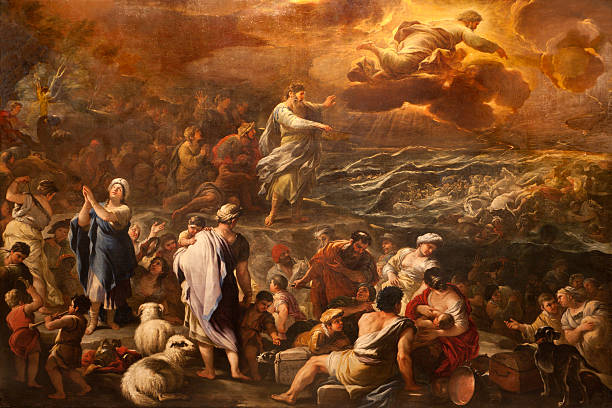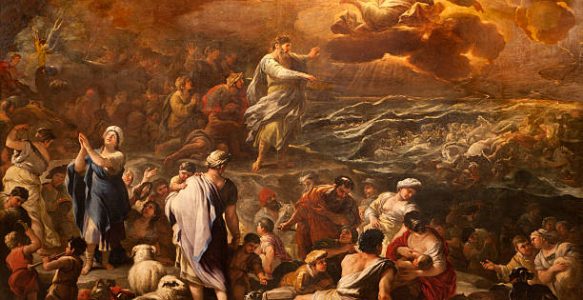Samantha Sawhney
Violence is a theme that heavily re-occurs through mythologies and religious traditions. Fundamentally, it acts as a means of punishing sin that is directly caused by an individual and perpetuated by inherited societal inaction.
Violence is a commonality between the book of Exodus (שְׁמוֹת) and Bhagavad Gita (श्रीमद्भगवद्गीता), two works ofdifferent genres in religious literature.
Exodus is the second of the first five books of the Hebrew Scriptures or Torah (תּוֹרָה) that recounts the liberation of the Israelites from the Egyptians. In the Exodus narrative, Moses (מֹשֶׁה) leads the disjointed Israelite people in the direction of God while receiving instruction and laws for the people. A major conflict is the resistance of the Pharaoh to free the Israelites from their captivity in spite of signs from God, provoking His wrath against Egypt.
The Bhagavad Gita is a segment of the Mahabharata (महाभारतम्), a story of a battle between the Pandavas (पाण्डव) and the Kauravas which acts as a microcosm of the fundamental moral laws that underpin the Mahabhratic universe. The story becomes a dialogue between Arjuna (अर्जुन), a kshatriya or warrior and Pandava, and Krishna (कृष्ण), one of the ten incarnations of Vishnu. Krishna justifieswhy it would be moral for Arjuna to slaughter his relatives in conflict.
The violence that is seen in the texts is largely personal and casts one party as virtuous and the other as sinful. In Exodus, the divisive force is ten plagues arbitrated against the Egyptians, the effects of which increase exponentially. They suffer as the result of existing in a time and place where the Israelites are oppressed. The text clarifies the relation between the Egyptians and Israelites saying, “[T]he Egyptians [were] well-disposed towards the people; Moses himself was very highly regarded by the Pharaoh’s servants and the people in the land of Egypt” (NABRE Ex 11:3). Yet God tells Moses that “Every first born in the land of Egypt will die” (NABRE Ex 11:4). A similar occurrence transpires in the Bhagavad Gita when Arjuna refuses to fight. “I would consider it better for the sons of Dhritarashtra to kill me unarmed and unresisting, rather than fight with them” (Bhagavad Gita 1:45).Krishna responds, “do not yield to this chastising impotence […] Give up such petty weakness of heart and arise, O chastiser of the enemy” (Bhagavad Gita 2:3). Krishna continues to use the permanence of the soul to justify violence, “No one is able to destroy the imperishable soul […] One who is in knowledge knows roar the self slays not nor is slain” (Bhagavad Gita 2:17-19).
Both texts use violence to communicate with disobedient populations in an arbitrary manner. The Egyptians favored Moses, and several Kauravas were not directly involved with the conflict that brought Arjuna and Krishna to the battlefield. Partisan divinities place two groups against one another against their wills, exposing the weight of societal sin over individual sin. The texts use violence as a means to condemn complicity. The first born Egyptians perish because they are implicated in the Pharaoh’s actions, not because they have directly wronged the Israelites. Similarly, all of the Kauravas inherit wrongdoing. Violence becomes an active response to a passive issue.
Divine violence in Exodus and the Bhagavad Gita punishes a complicit society for an individual transgression against the will of divinity. The plagues of Egypt and the sufferings of the Kauravas express sin as societally pervasive.
Works Cited
The Bible. New American Bible, Revised Edition.
Swami Prabhupā, A.C Bhaktivedanta, translator. Bhagavad Gītā as It Is. Bhaktivedanta Book Trust, 1972.



Itís difficult to find well-informed people about this topic, however, you seem like you know what youíre talking about! Thanks
Good post. I definitely appreciate this website. Stick with it!
Good post. I learn something new and challenging on blogs I stumbleupon on a daily basis. Its always exciting to read content from other authors and use a little something from other web sites.
Скачать Winline для мобильных устройств и компьютеров
Wow, this article is nice, my sister is analyzing such things, thus I am going to convey her.
Nice post. I was checking continuously this weblog and I’m impressed! Extremely useful information specially the final section 🙂 I take care of such information a lot. I was seeking this certain information for a very long time. Thank you and good luck.
Unquestionably consider that which you said. Your favourite justification seemed to
be on the internet the easiest thing to take into account
of. I say to you, I definitely get annoyed at the same
time as other people think about worries that they just don’t realize about.
You managed to hit the nail upon the highest and defined out the whole thing with no need side-effects ,
other folks could take a signal. Will likely be back to get more.
Thanks
I have been browsing on-line greater than 3 hours today, yet I never discovered any fascinating
article like yours. It is pretty price sufficient for me.
In my view, if all web owners and bloggers made just right
content material as you probably did, the net will probably be a lot more useful than ever before.
Ahaa, its fastidious dialogue concerning this paragraph at
this place at this blog, I have read all that, so now me also
commenting at this place.
I have been surfing online more than 4 hours today, yet I never found any interesting article like yours.
It is pretty worth enough for me. Personally, if
all site owners and bloggers made good content as you
did, the internet will be a lot more useful than ever before.
thank you very much
Have you ever thought about adding a little bit more than just your articles? I mean, what you say is valuable and everything. However think of if you added some great images or videos to give your posts more, “pop”! Your content is excellent but with images and clips, this blog could definitely be one of the greatest in its field. Awesome blog!
I am sure this post has touched all the internet visitors, its really
really nice article on building up new blog.
This is a topic which is close to my heart… Many thanks!
Where are your contact details though?
I am sure this article has touched all the internet viewers, its really really nice post
on building up new weblog.
Ahaa, its nice discussion regarding this post at this place at this weblog, I have read all that,
so at this time me also commenting here.
Everyone loves what you guys are usually up too. Such clever work and exposure!
Keep up the good works guys I’ve incorporated you guys to my
personal blogroll.
Way cool! Some extremely valid points! I appreciate
you writing this article and the rest of the website is very good.
Wow, this piece of writing is nice, my younger sister is analyzing these kinds of things, thus I am
going to inform her.
These are actually wonderful ideas in about blogging.
You have touched some pleasant points here. Any way keep up wrinting.
I would like to point out my passion for your generosity in support of men and women that actually need guidance on this niche. Your personal dedication to getting the solution all through was unbelievably practical and have consistently made guys just like me to attain their dreams. Your amazing valuable tips and hints indicates a great deal to me and even more to my peers. Warm regards; from everyone of us.